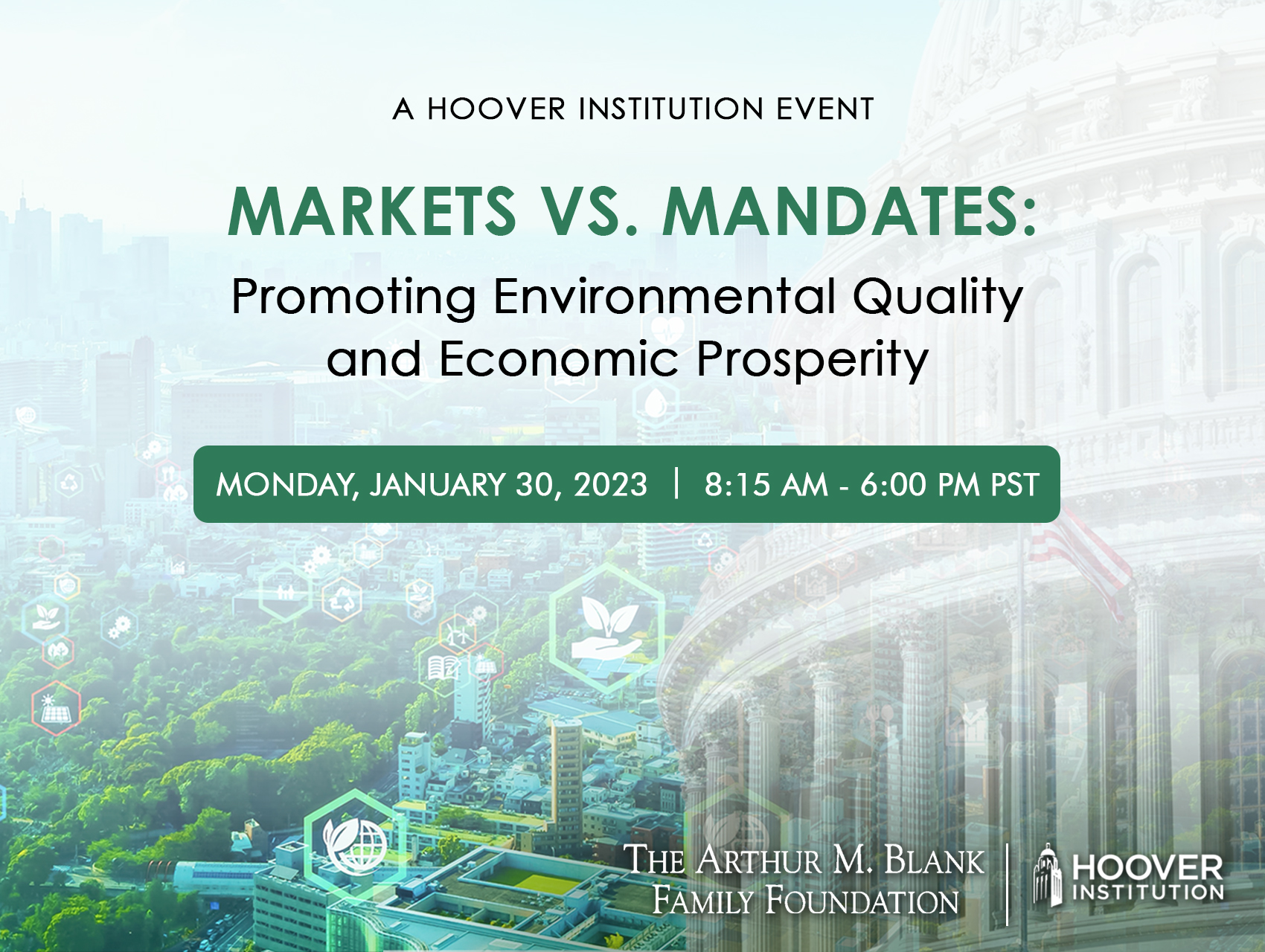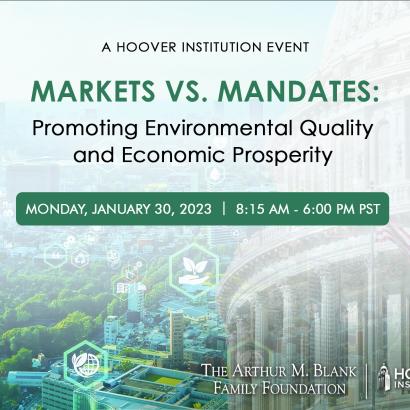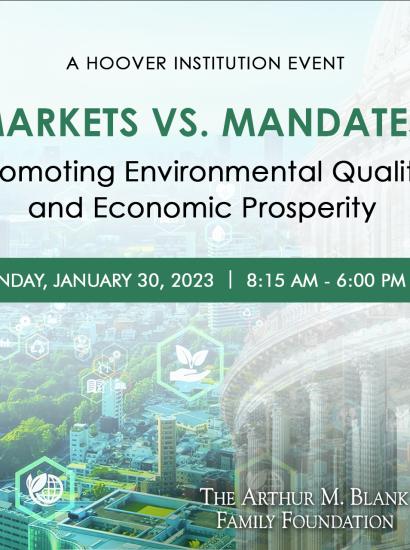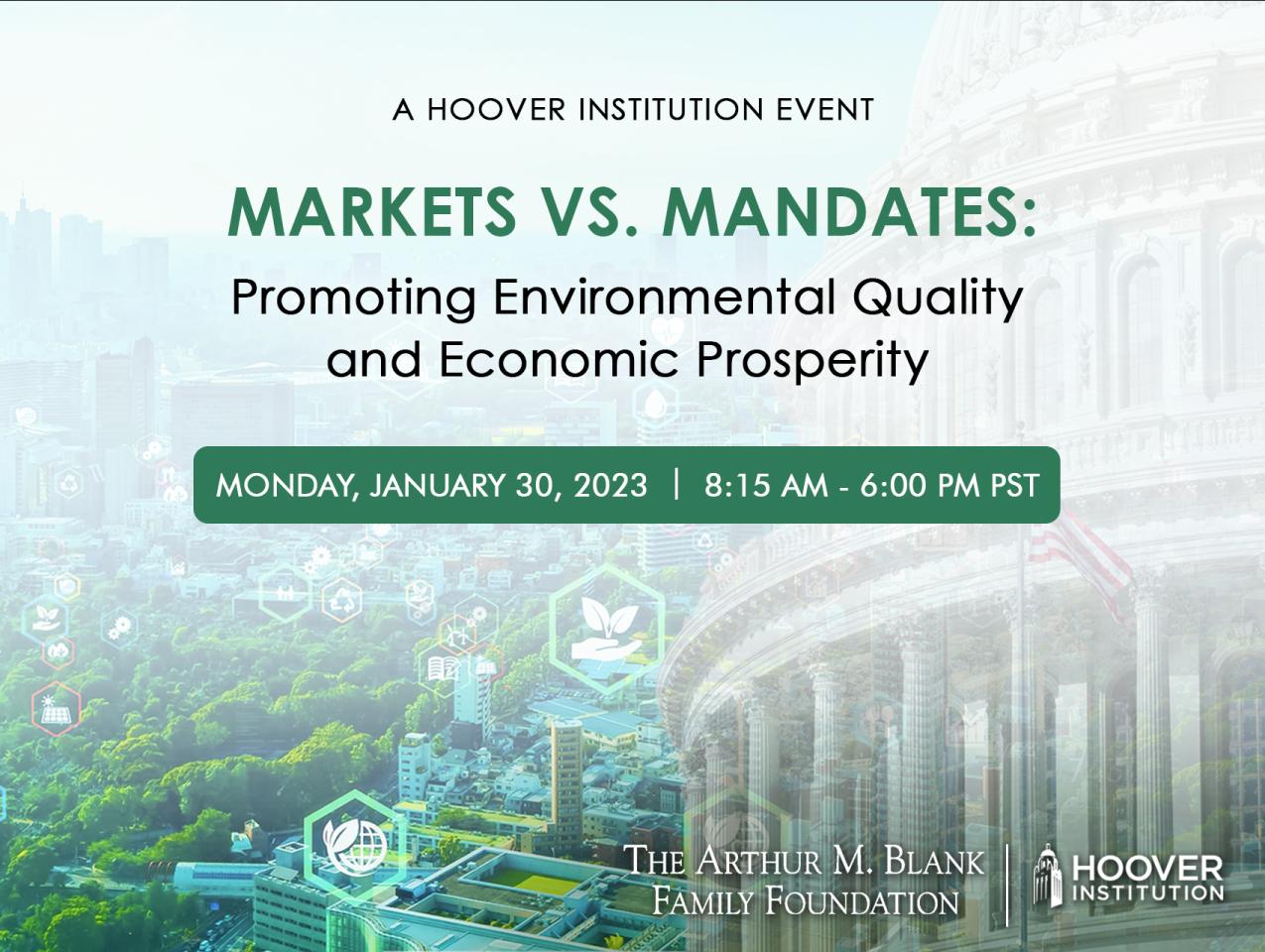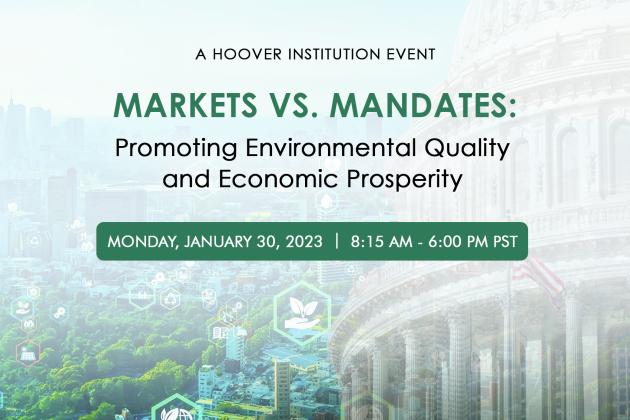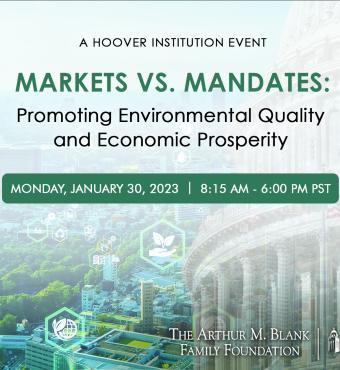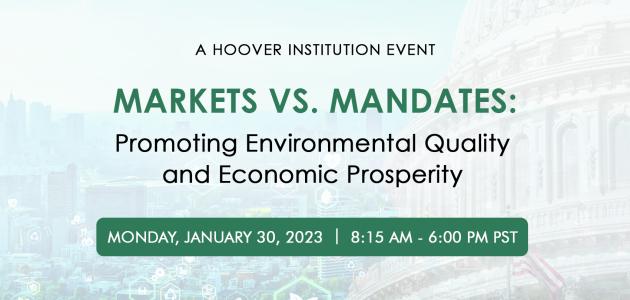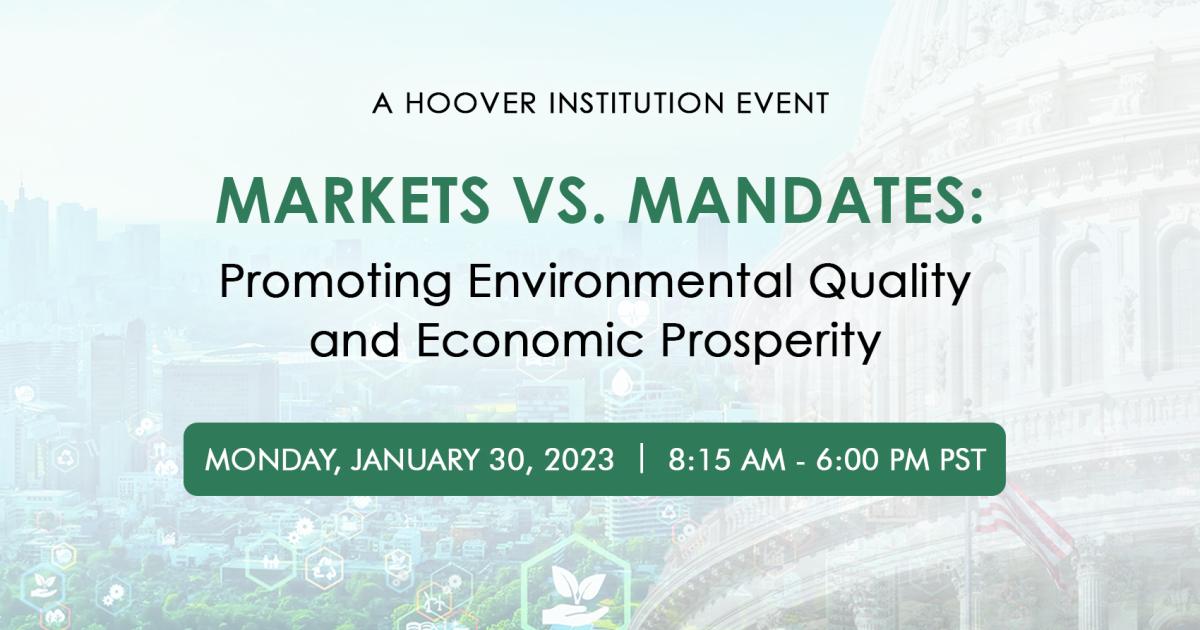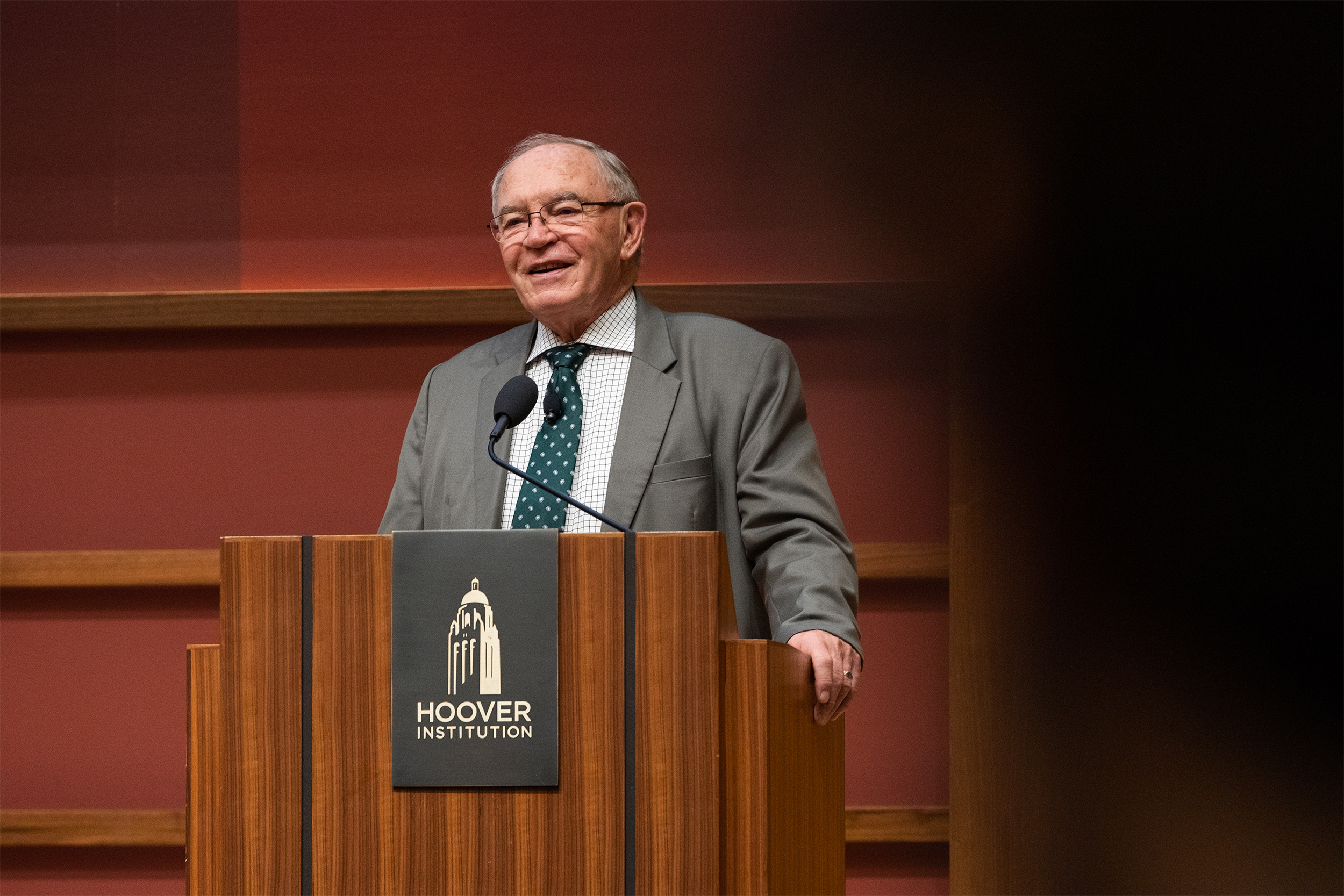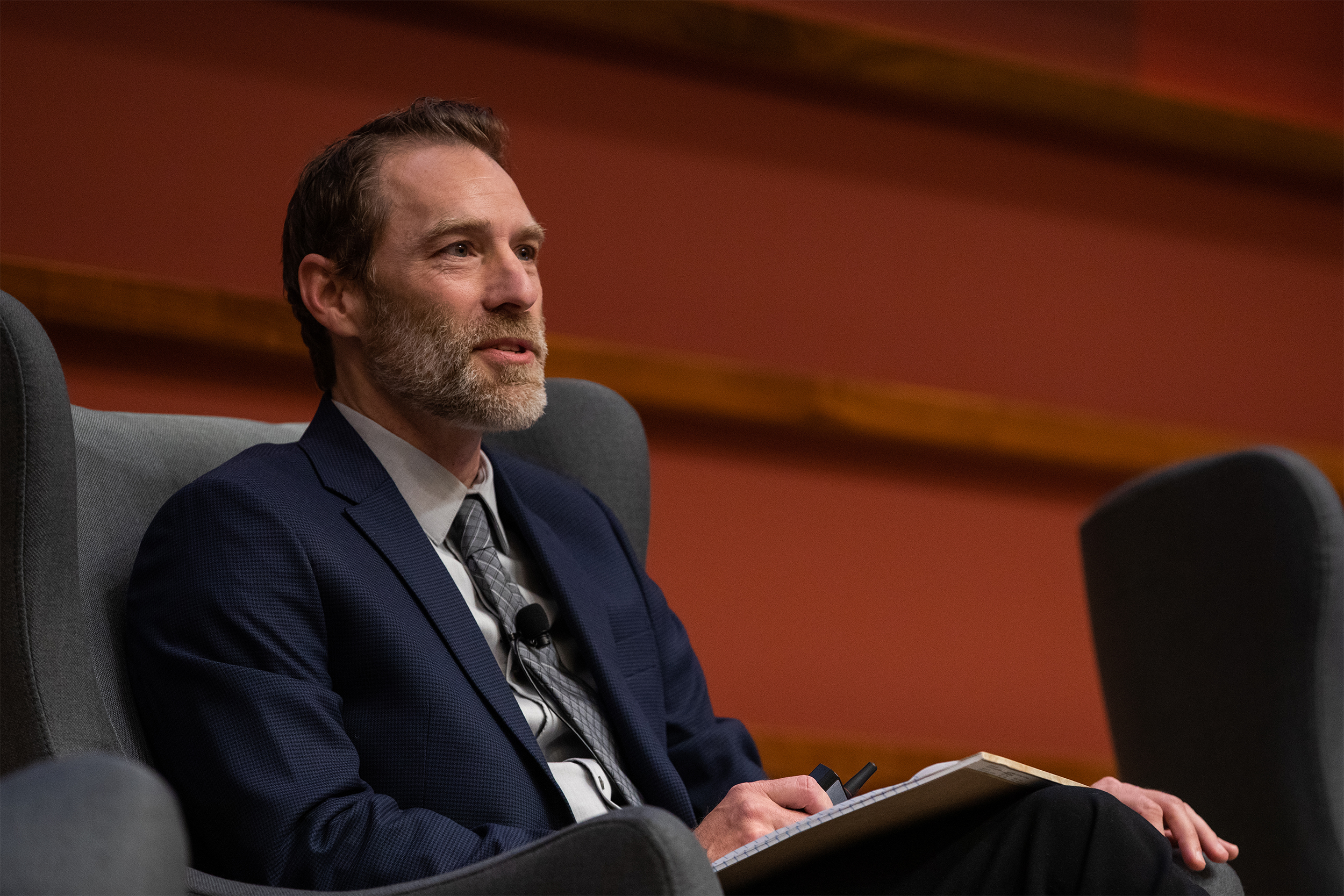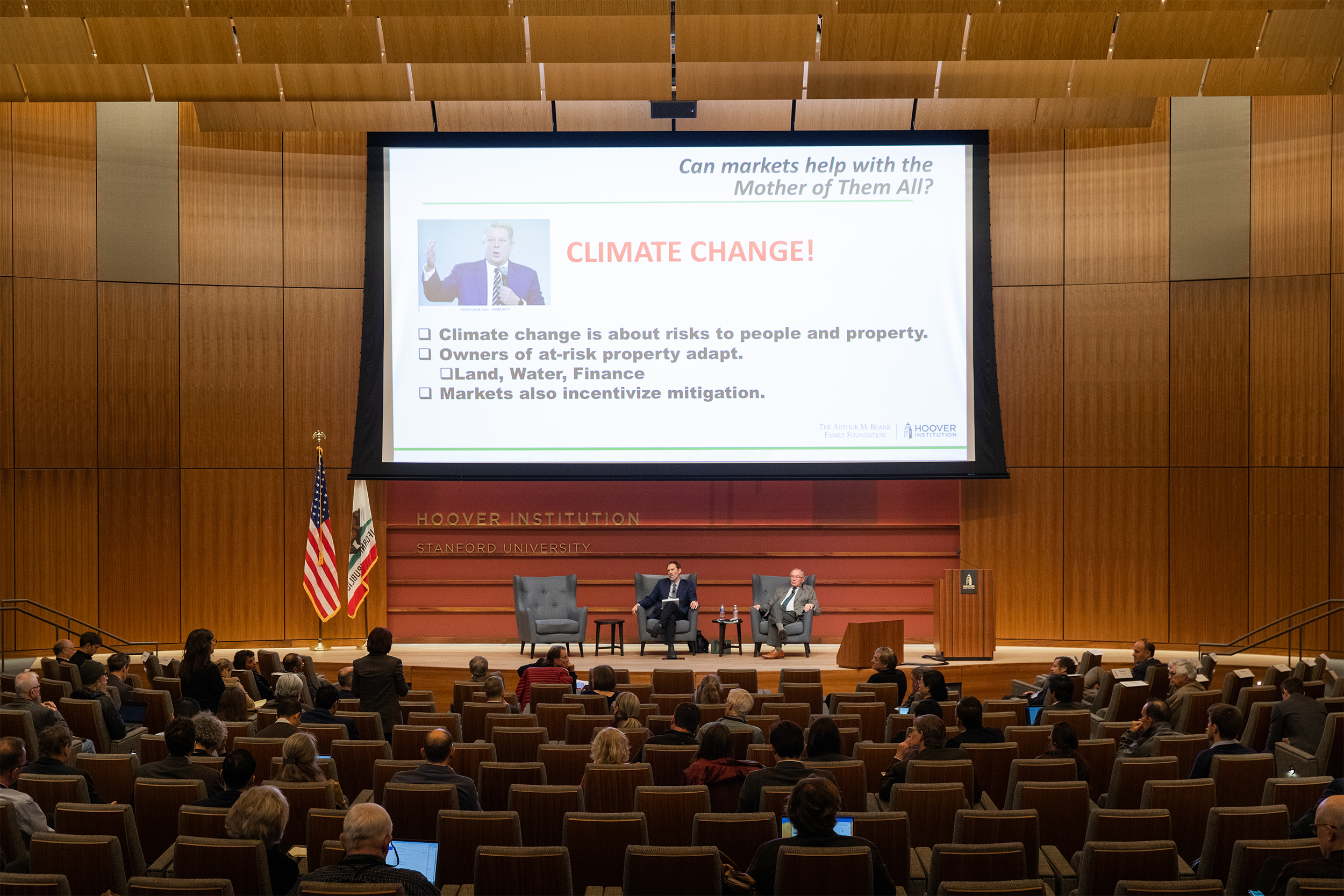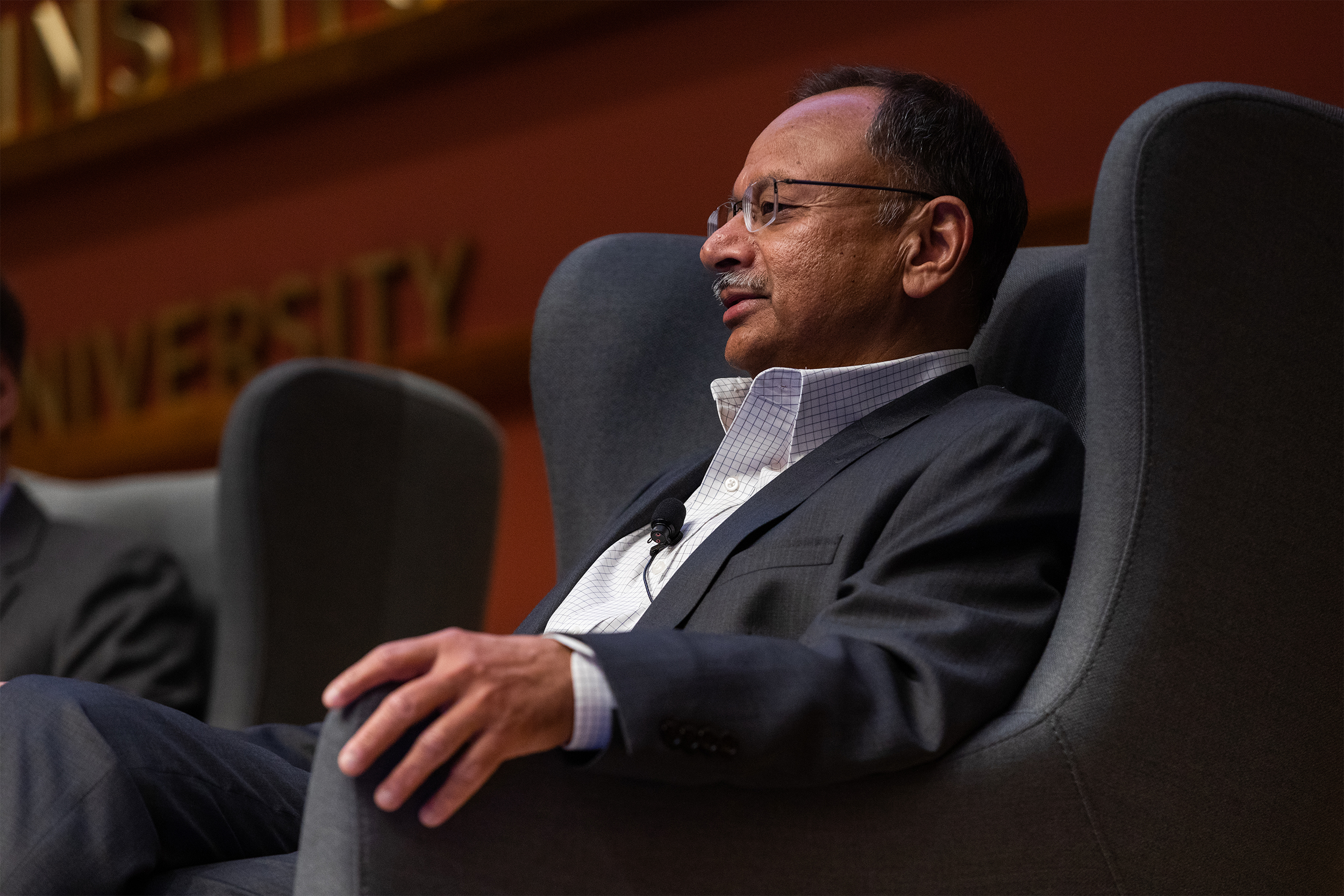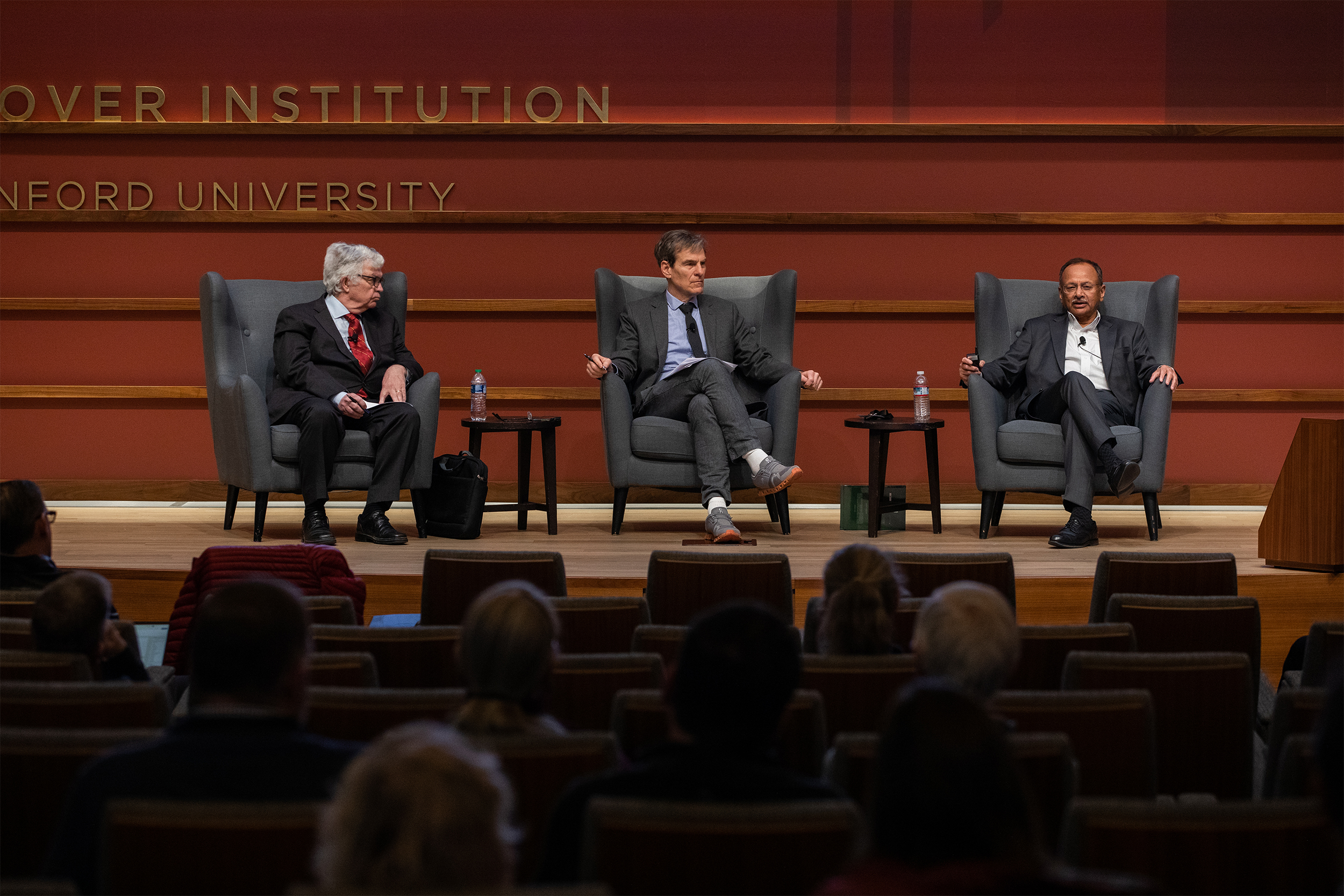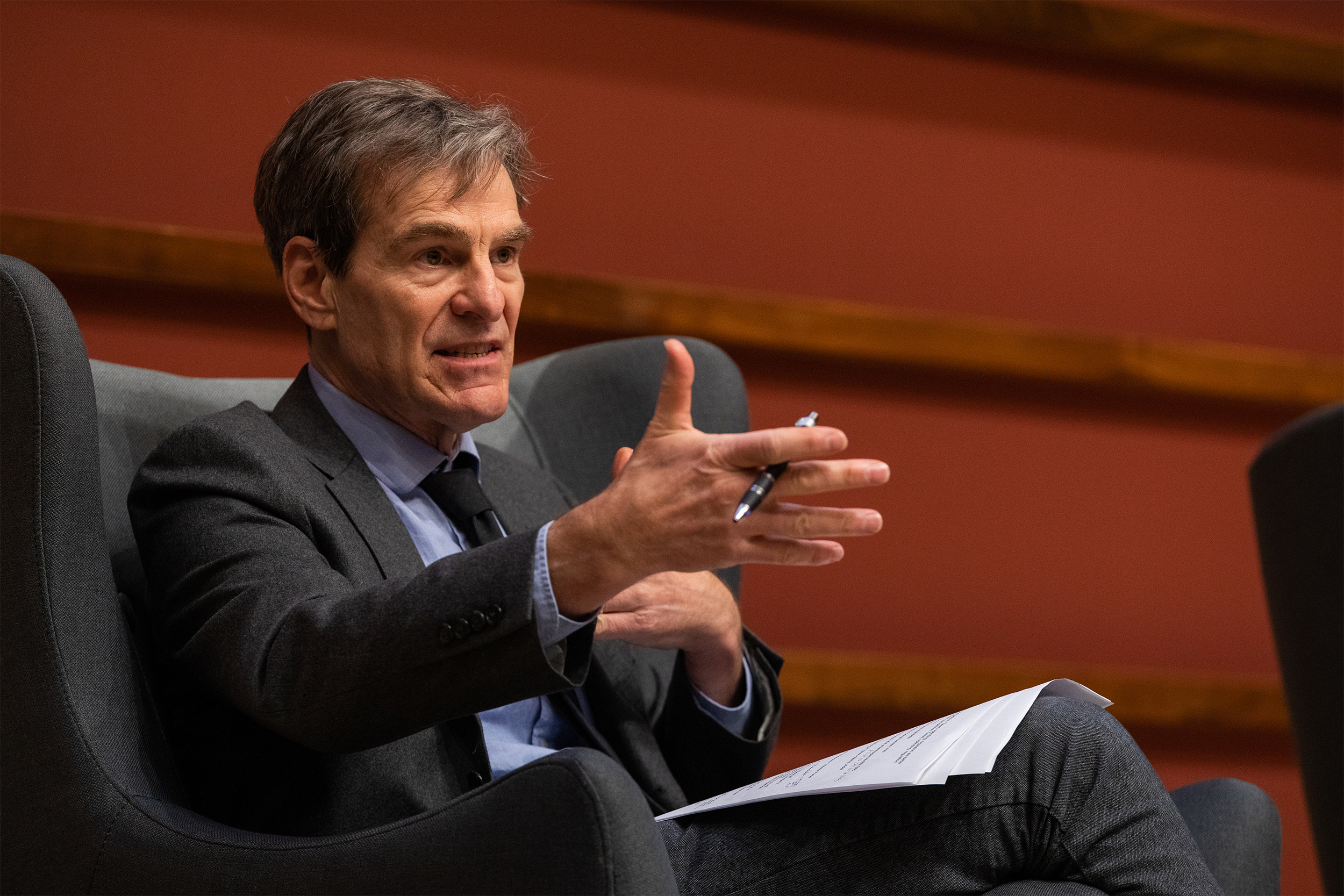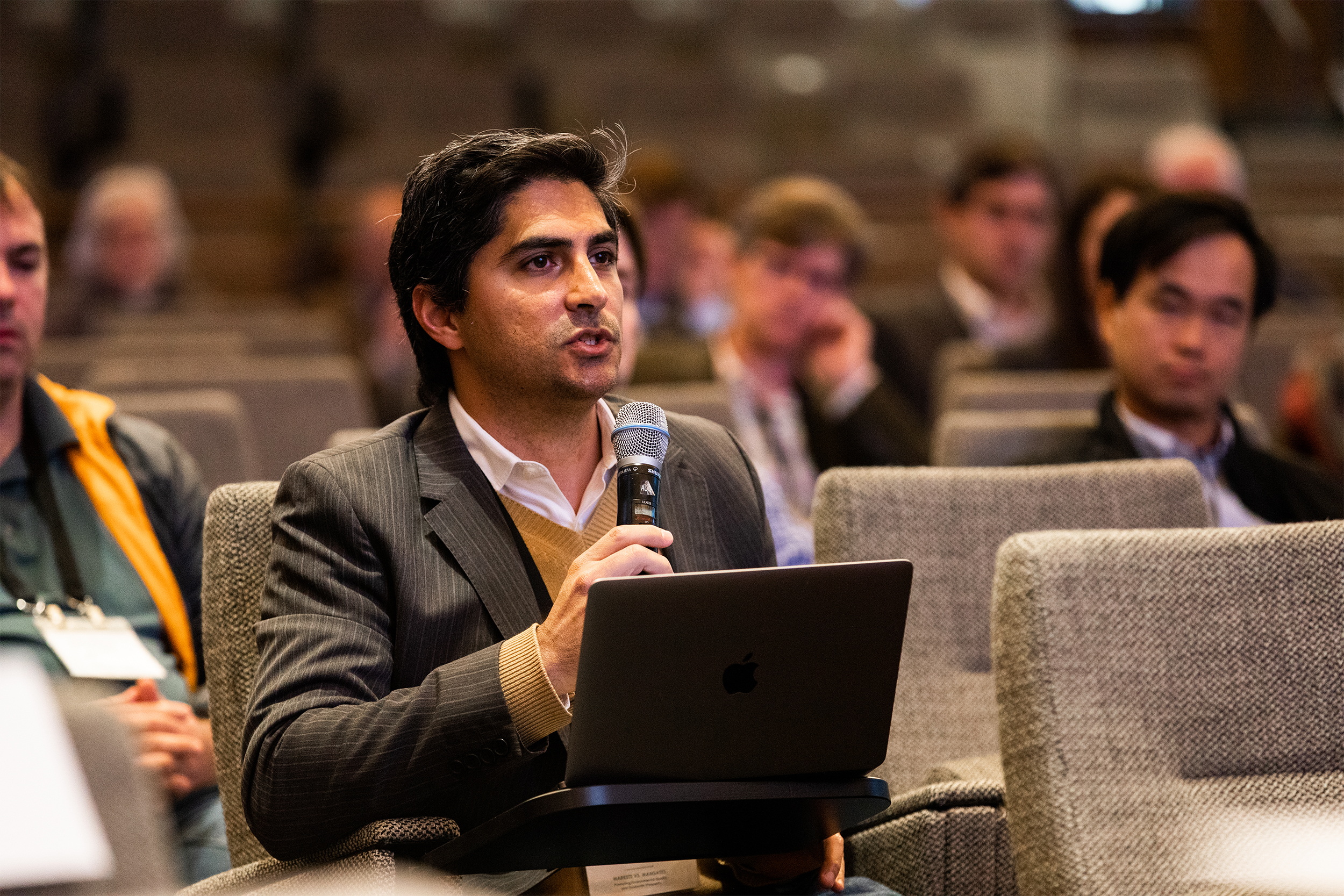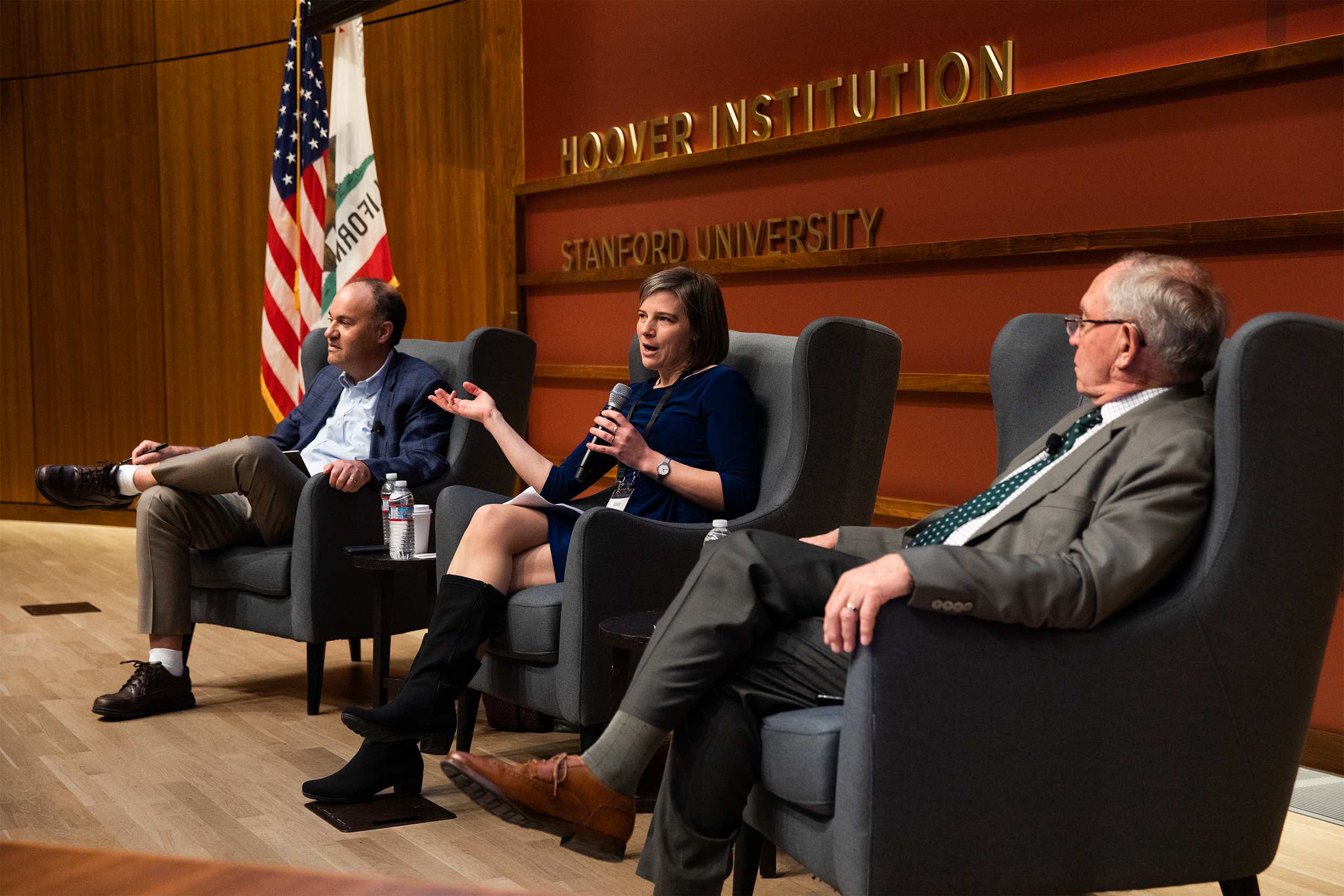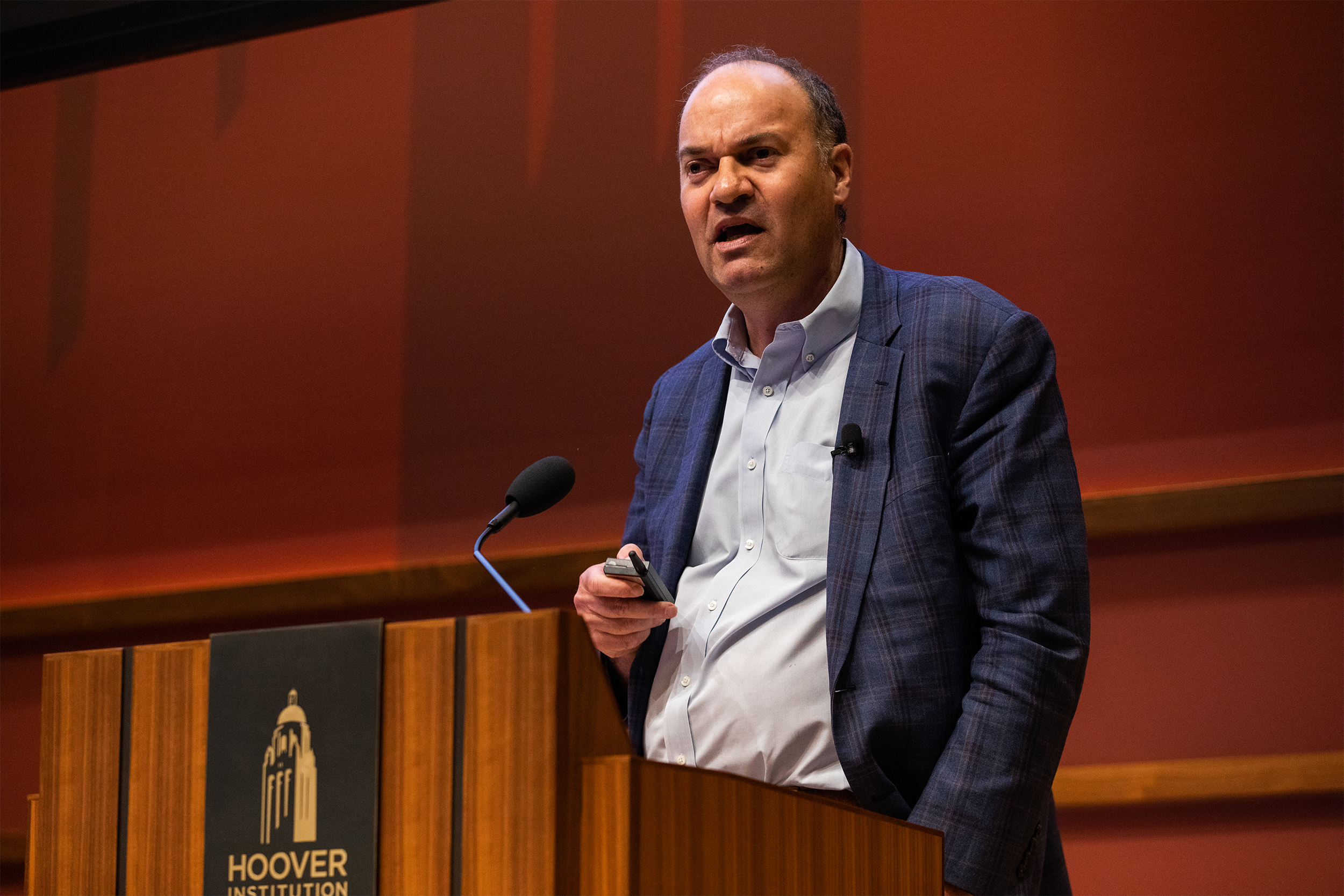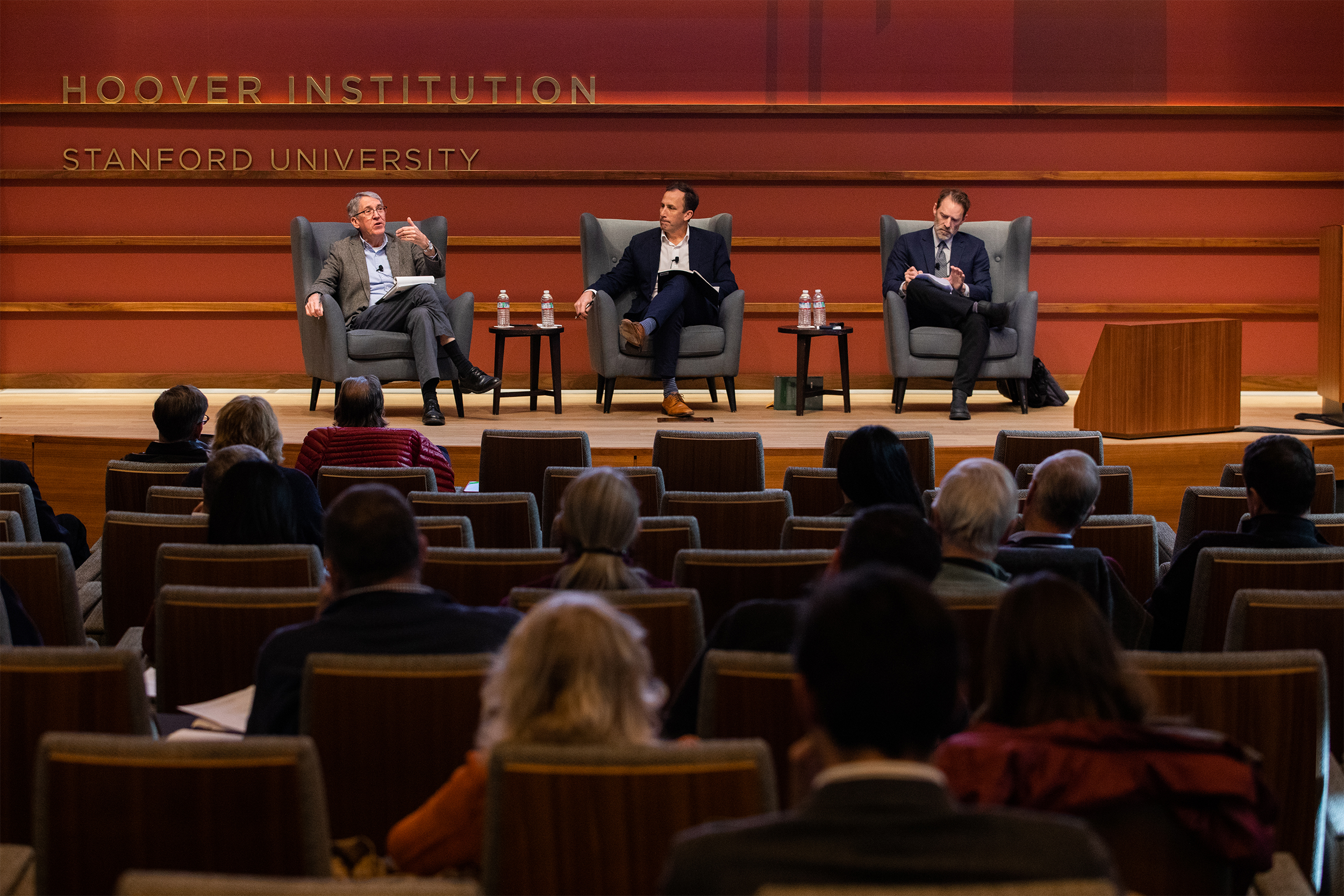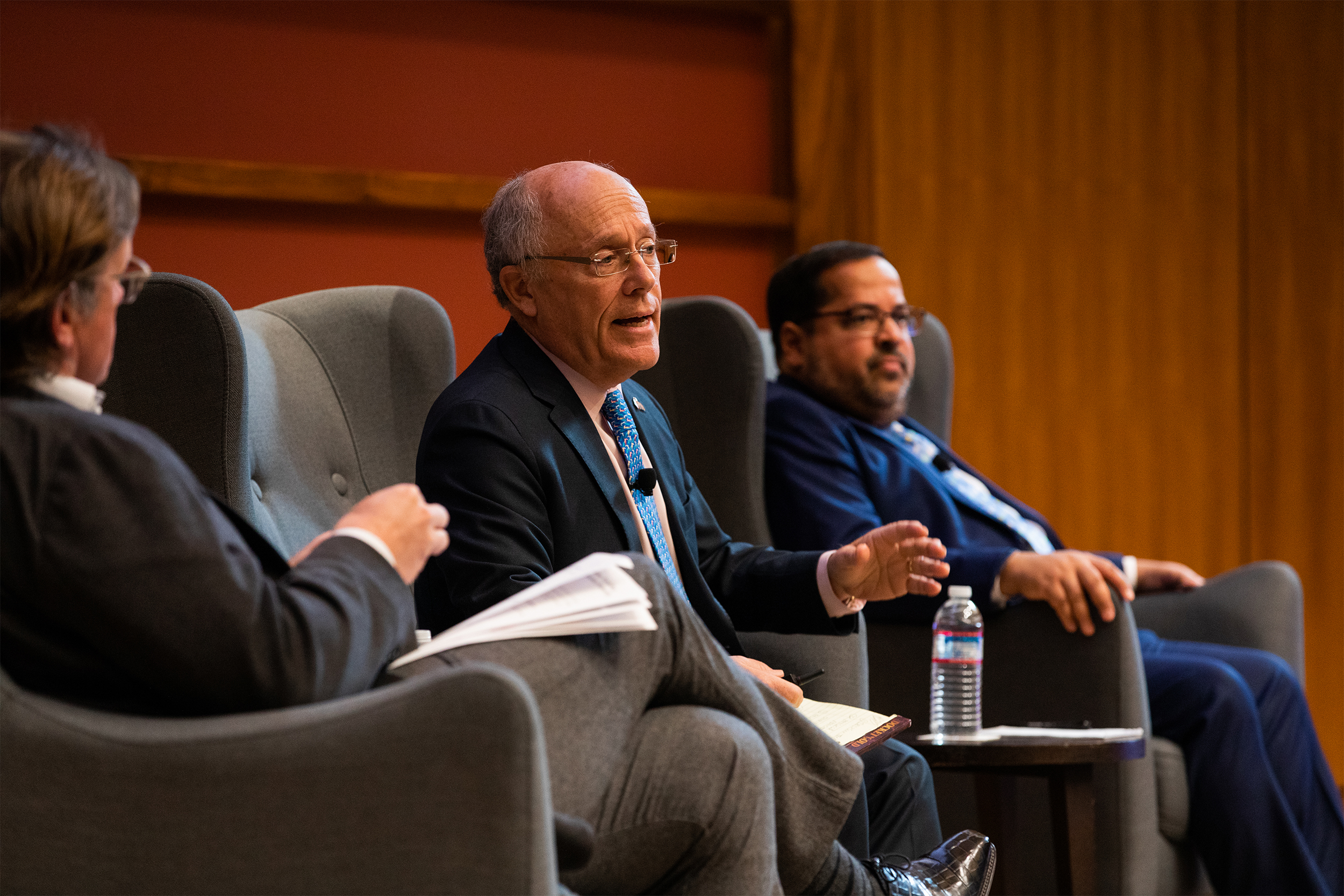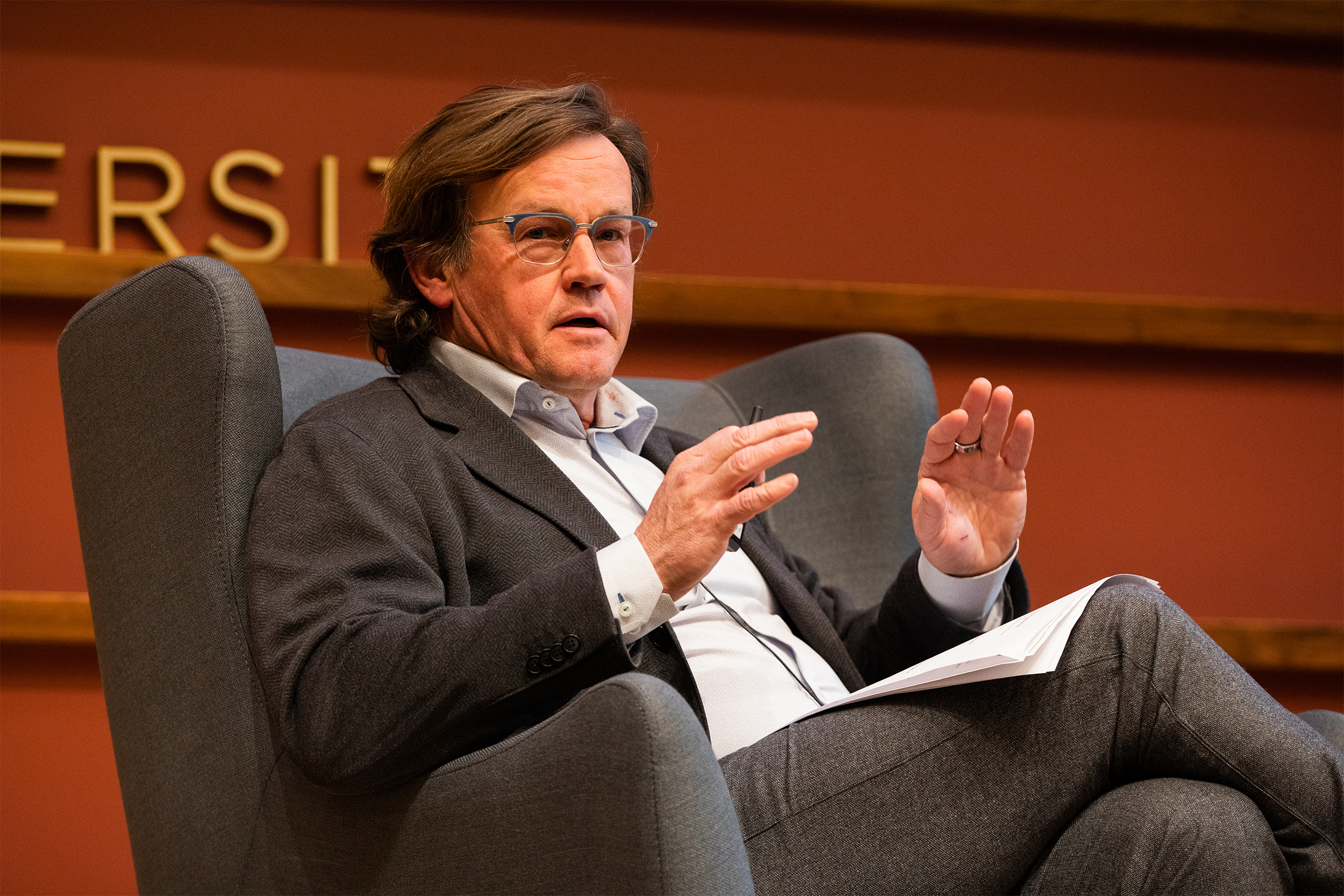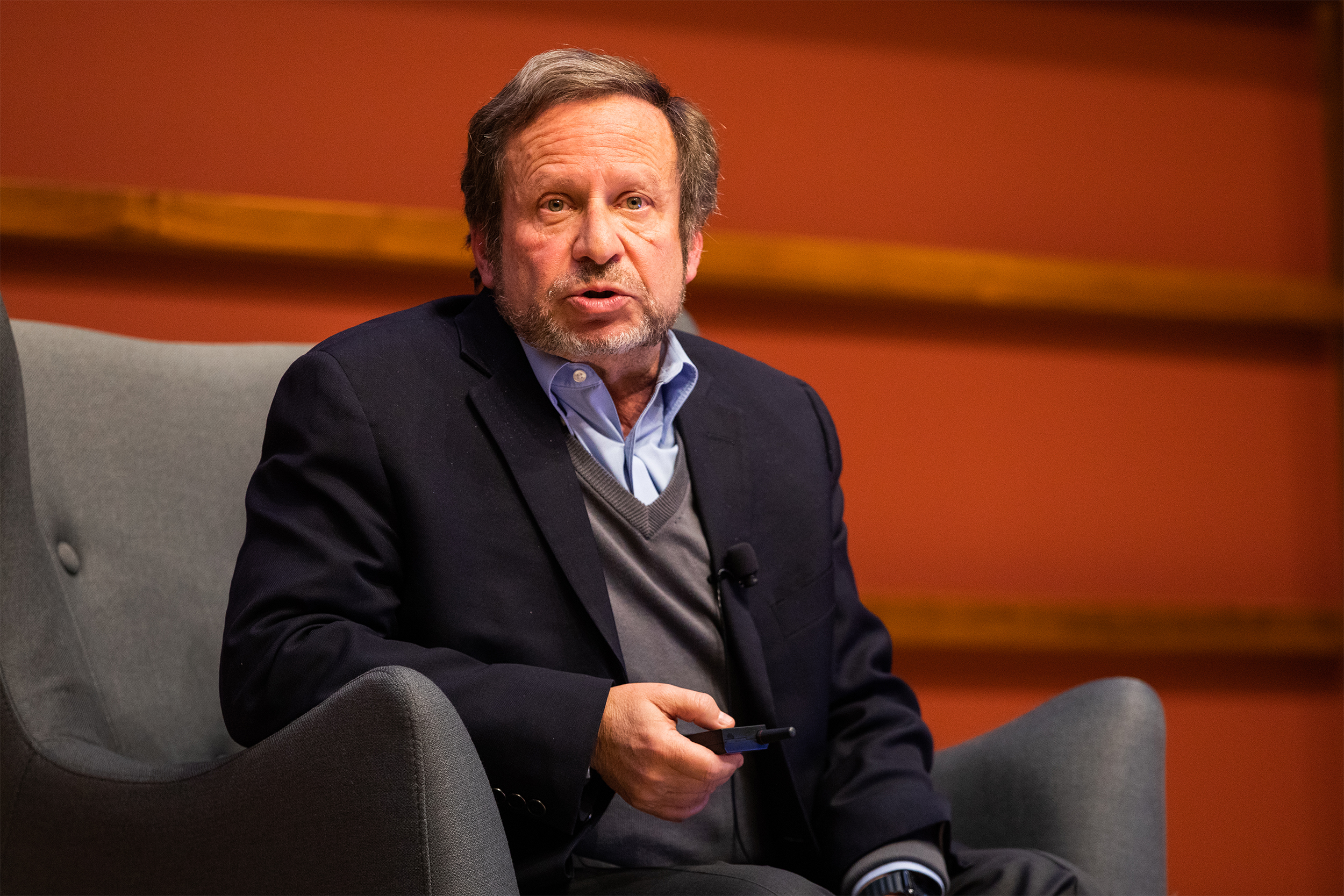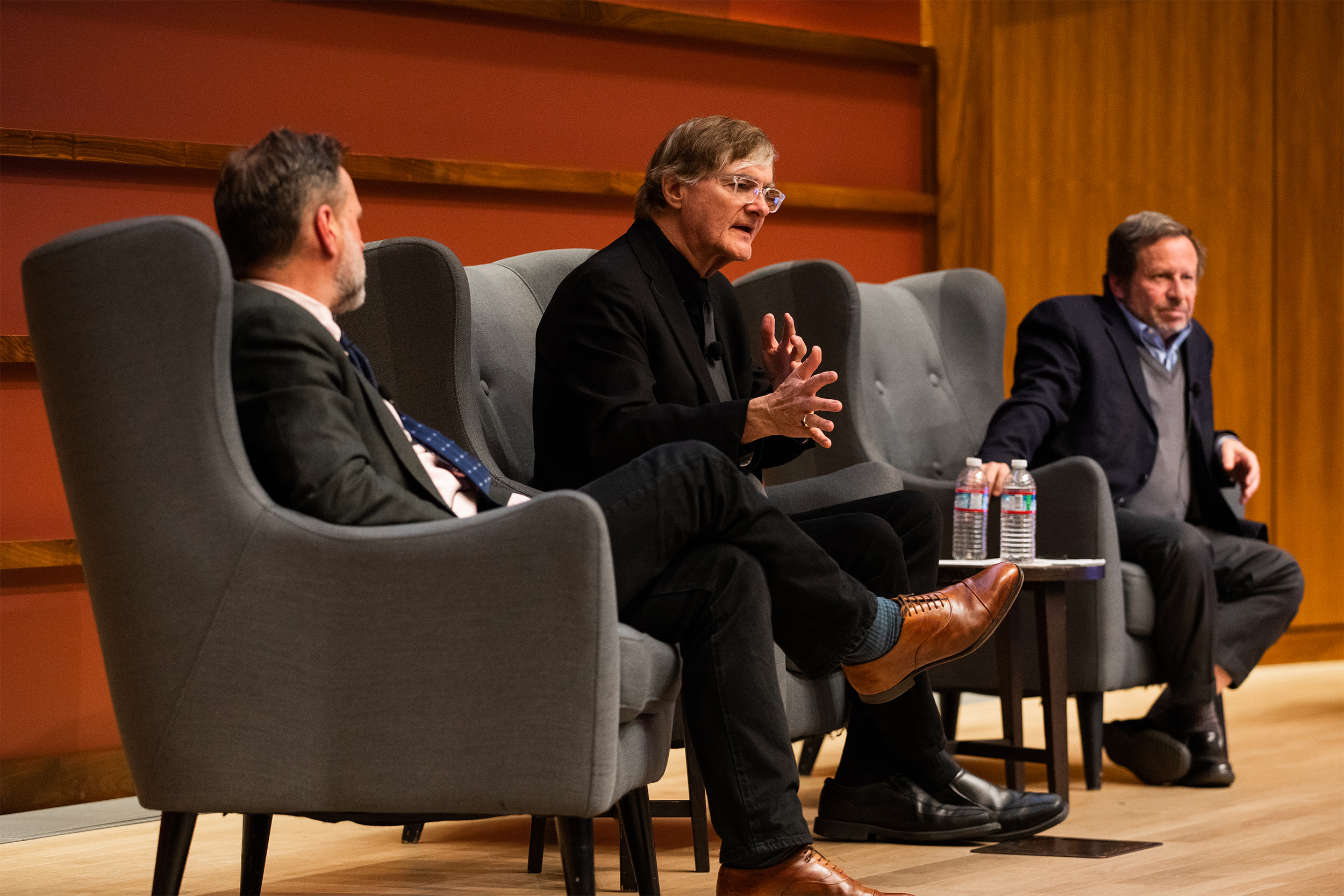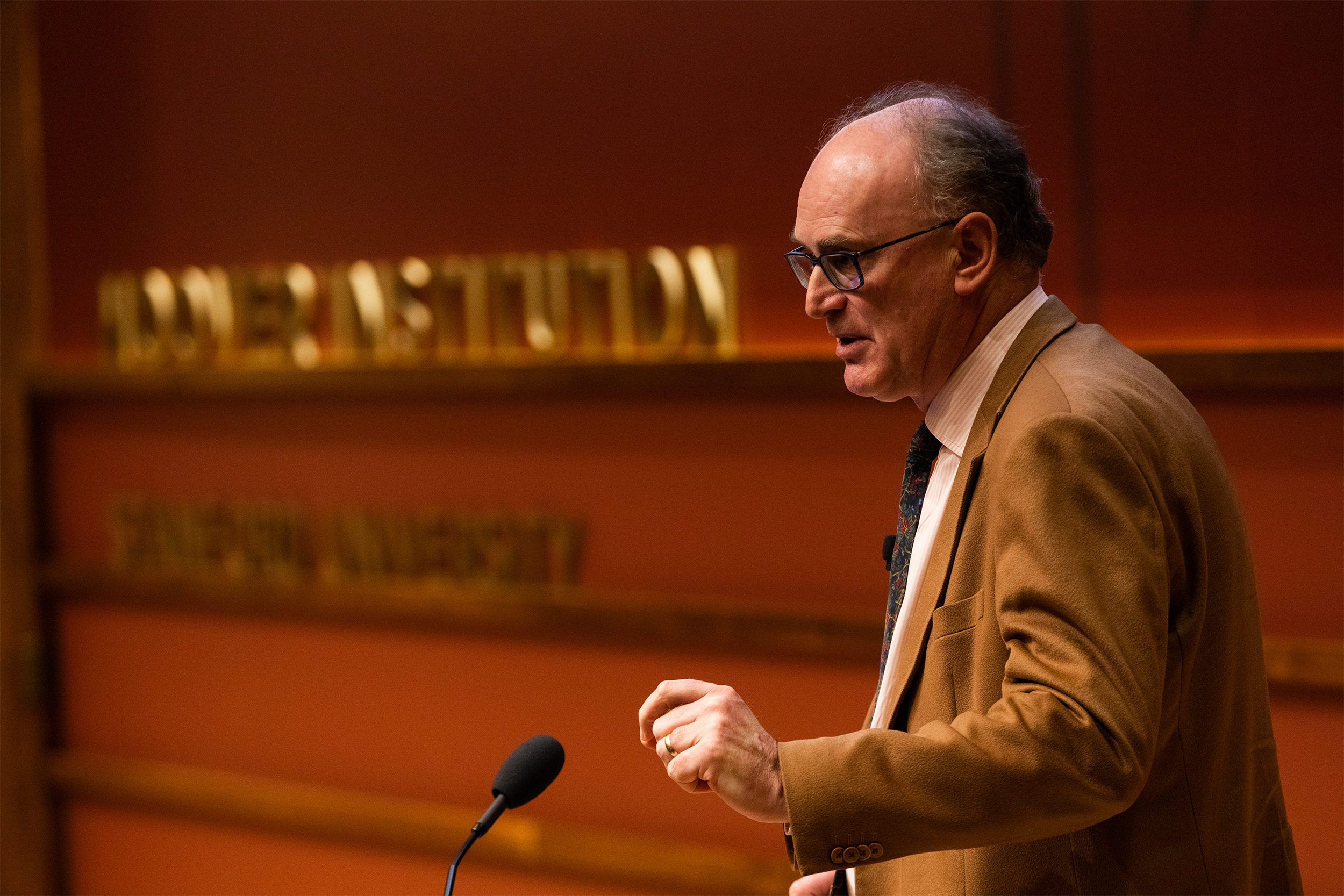Hoover Institution (Stanford, CA) – On January 30, the Hoover Institution hosted Markets vs. Mandates, a daylong conference featuring an interdisciplinary lineup of speakers who examined the role of markets and government regulation in promoting environmental quality and economic prosperity. More than 120 people attended sessions, which were open to the public.
Spearheaded by distinguished Hoover economists Terry Anderson and Dominic Parker, Markets vs. Mandates, was made possible through the generosity of the Arthur Blank Family Foundation. Presenters discussed a variety of topics, including the trade-offs of both market-driven and regulatory approaches to environmental protection; the performance of investments that are considered to adhere to ESG (environmental, social, and governance) principles; how people and businesses can use markets to adapt to climate change; the appropriate use of markets and mandates for mitigating emissions and conserving land, habitats, and natural resources; the costs and benefits of transitioning to energy alternatives; and the social advantages of carbon dioxide emissions.
Introduction by Condoleezza Rice
Hoover director Condoleezza Rice introduced the conference by recalling the institution’s long history of researching environmental policy issues.
Rice explained how the imitable George P. Shultz was a pioneer in advancing environmental solutions. In partnership with Tom Stephenson, former chair of the Hoover Board of Overseers, the late secretary of state formed a task force dedicated to identifying pragmatic policies aimed at strengthening America’s energy security while providing environmental protection.
Rice said that the Markets v. Mandates conference marks a relaunch of Hoover’s research on environmental policy challenges. Rice explained that since her days as secretary of state there has been a principal set of such challenges that every nation must reckon with. She referred to these as the “three Es”: economic growth, environmental stability, and energy mix.
Rice affirmed that if a country can get that energy equation right, it is likely to have a sustainable environmental policy.
The seven sessions and their summaries are as follows:
Session 1: Thinking Clearly about Markets and Mandates
Presenters: Terry Anderson, John and Jean De Nault Senior Fellow, Hoover Institution; and Dominic Parker, Ilene and Morton Harris Visiting Fellow, Hoover Institution
Presentation Slides by Terry Anderson and Dominic Parker
Summary
Terry Anderson began the conference sessions by providing definitions for mandates and markets in their environmental contexts. Mandates (or rules) means that politics and administrations assign environmental objectives and use fixed command-and-control mechanisms to achieve them. On the other hand, markets are based on processes whereby resource owners respond to changing values.
Dominic Parker examined the trade-offs of both market-driven and mandate approaches to environmental policies. He explained that there are cases in which mandates have proved effective, but that their policy outcomes should be analyzed with a nuanced perspective.
For example, following the federal government’s adoption of enforceable measures on sulfur dioxide emissions through the Clean Air Act, the benefits of initial reductions of acid rain came at very high costs to the economy. However, in ensuing decades, market trading of emission permits lowered the costs of complying with the restrictions, such that the benefits of these measures eventually far outstripped the costs. Similarly, bans in state-level jurisdictions on the commercial hunting of white-tailed deer reversed that species from near-extinction at the turn of the 19th century and exponentially increased their population to a level today at which they pose a risk of colliding on roads with automobiles and other vehicles.
Parker described other mandates that have had unintended consequences, such as the Endangered Species Act of 1973. In many instances, property owners have destroyed habitats preemptively in order to prevent scrutiny from regulators enforcing this legislation. Meanwhile, bans on carryout plastic bags in stores have increased consumption of other kinds of plastic, and prohibitions on hydraulic fracking have resulted in increased reliance on power plants that pollute the air with coal emissions.
Anderson explained the effectiveness of markets in wildlife conservation efforts. He cited a case in which the Nature Conservancy, a well-funded global advocacy organization, utilized technology to crowdsource rice farmers in transferring water to habitats for migratory birds. In another example, Anderson referred to Parker’s sabbatical in New Zealand, in which he witnessed the World Wildlife Fund using a market-driven approach to change the behavior of commercial fishing companies to protect endangered species in the Great Barrier Reef. Instead of advocating for a mandate against fishermen, the fund paid them to stop their activity near the species’ habitats altogether.
Session 2: Corporate Responsibility, ESG Investing, and Climate Disclosures
Presenters: Sanjai Bhagat, professor of finance at the University of Colorado–Boulder; and John H. Cochrane, Rose-Marie and Jack Anderson Senior Fellow, Hoover Institution
Chair: John Taylor, George P. Shultz Senior Fellow in Economics, Hoover Institution
Presentation Slides by Sanjai Bhagat
Summary
Sanjai Bhagat explained that ESG investing principles and new standards of corporate social responsibility are not based on the fiduciary duty to maximize shareholder value. They are primarily centered, he said, on maintaining the well-being of societal stakeholders, including customers, employers, suppliers, and communities, as well as particular objectives such as environmental justice.
Bhagat argued that investments in which the unifying principle is shareholder supremacy not only maximizes shareholder value but also can potentially enhance the above-described societal stakeholder paradigm. Meanwhile investments that place the societal stakeholder paradigm as paramount have been consistently underperforming.
In adhering to traditional concepts of shareholder value, companies can more reliably deliver benefits to societal stakeholders than through compliance to a specific set of dictates advanced by government agencies. In maximizing value for shareholders, these companies will want to retain productive employees and build trust with their customers. He added that by focusing on shareholder value, companies can also afford to maintain sustainable environmental standards.
John Cochrane asserted that the Security and Exchange Commission’s plan to enforce ESG investment practices isn’t based on “saving the planet” but on bending corporations to serve a particular political agenda. Echoing Bhagat, Cochrane said the ESG mandates would not maximize shareholder value. It would instead deny capital to companies, lower their asset prices, and curb returns to investors. ESG mandates would also pervert markets, destroy competition, and encourage some companies to rent-seek from the government.
Cochrane recommended that Americans focus more on the environmental effects of climate change than its economic effects, the latter of which he asserted are trivial and don’t justify radical policy action.
Cochrane argued that American governmental institutions, including the Federal Reserve, are advocating costly policies intended at mitigating climate risk to the financial system. For example, he said that regulations intended to transition away from fossil fuels will make energy more expensive, while causing more destruction to the American economy more than it helps economies elsewhere in the world, especially in poor countries. He maintained that the only option to improve the climate without hurting GDP is to enable firms to freely respond to market forces and produce innovations in clean and affordable energy.
Session 3: Adapting to Climate Change
Presenters: Matthew Kahn, Provost Professor of Economics and Spatial Sciences, University of Southern California; and Maria Waldinger, Deputy Director of the Ifo Center for Labor and Demographic Economics
Chair: Terry Anderson, John and Jean DeNault Senior Fellow, Hoover Institution
Presentation Slides by Matthew Kahn
Maria Waldinger provided a historical analysis of how societies have adapted to climate conditions. The oldest adaptation strategy was migration, she explained, which was more easily achieved when societies were nomadic and there were no political boundaries. More modern societies have adopted various processes to ensure their survival. She explained that crop failures were an omnipresent feature of European societies between the 14th and 19th centuries, a period of regional cooling that has been referred to as the “little ice age.”
Her research explores the adaption of people living in Southern Germany and Sweden. In both societies, people ensured against starvation through migration, including to the United States in the 19th century. Each society’s political leadership enacted programs aimed at becoming resilient to harsh weather in order to retain their labor forces. Sweden introduced social safety nets, while in the Southern German society she investigates, the government educated their population about methods of agricultural production.
Broader access to trade, however, became a powerful tool for European societies to strengthen their climate resilience. As an example, Waldinger described how after wheat crops in Europe were decimated in the 19th century, many agricultural economies replaced them with imported potatoes from the Americas, which thrived in cooler temperatures.
Matthew Khan outlined to the audience how markets can provide optimal incentives for adaption to climate change and reduce its economic effects. If enough people are facing a challenge, markets are the mechanisms that can empower entrepreneurs to produce and deliver innovations, Kahn maintained.
As an example, he pointed to the invention of the air conditioner, which has enabled people to adapt and work productively in hotter climates. As technology has advanced, the use of air conditioning has become more efficient and less expensive.
Kahn said adaption can be facilitated by loosening government regulations. He explained, for example, that in Berkeley, California, the scarcity of affordable housing pushed some people to live in zones that are at high risk of fire. By contrast, if the local government in that city enabled real estate markets to operate more freely, builders could add new homes to safer areas where new construction had previously not been permitted.
Kahn also hailed the invention of new technologies that accelerate adaption and diffusion of knowledge. He pointed to the work of the First Street Foundation, which has deployed advanced web-based tools that provide users with access to data on the risk of fire, severe heat, and flooding to their homes or to real estate they are considering for purchase.
Session 4: Markets for Mitigation and Conservation
Presenters: Christopher Costello, distinguished professor of resource economics, Bren School of Environmental Science & Management, University of California—Santa Barbara; and Barton “Buzz” Thompson, Robert E. Paradise Professor of Natural Resources Law, Stanford University Law School
Chair: Dominic Parker, Ilene and Morton Harris Visiting Fellow, Hoover Institution
Summary
During his remarks, Christopher Costello articulated the advantages of markets over regulatory approaches to conservation and mitigation of harms inflicted on the environment. As an example, he described that the coastal waters of Santa Barbara are home not only to one of the most biodiverse maritime habitats in America but also to some of the busiest shipping lanes in the world. These circumstances have resulted in large container vessels causing harm to maritime wildlife while traveling to and from the Port of Los Angeles.
In attempting to mitigate this damage, Costello said, public officials met with little success when they tried to enforce limitations on the speed of the vessels. Government, nonprofit, and maritime industry groups devised a plan to pay $2,500 incentives for operators of vessels if they slowed down and avoided collisions with wildlife. Costello said that these incentives provided additional benefits to shipping companies. These included saving money by reducing emissions and receiving positive public relations by taking appropriate care to evade the endangerment of wildlife.
Buzz Thompson provided another example of the feasibility of markets for environmental protection. Delivery of water from the Colorado River was weakening the flow of its stream and, in turn, endangering its fish population. He explained that limiting water to farmers would have been a daunting challenge. Understanding this reality, authorities instead paid farmers for access to their water rights so that they could strengthen the flow of the river.
These and other examples of market-driven conservation (such as those supported by the Nature Conservatory and the World Wildlife Fund mentioned in earlier discussions) present a free-rider dilemma, whereby a handful of philanthropists are providing benefits to a larger proportion of the public who are not required to pay. Costello and Thompson maintain that despite this inequity, this market approach is far more favorable to mandates with all their inefficiencies.
The speakers explained that environmental markets can also benefit poor populations, and this may help explain the global trend toward payments for the voluntary provision of environmental services.
Session 5: Adding Economics to Energy Engineering
Presenters: Mark P. Mills, senior fellow, Manhattan Institute; and David Victor, professor of innovation and public policy, University of California–San Diego
Chair: Neil Chatterjee, senior advisor, Hogan Lovells, and former commissioner and chairman of the Federal Energy Regulatory Commission
Presentation Slides by David Victor
Presentation Slides by Mark Mills
Summary
Mark Mills argued that ambitious goals to achieve zero carbon emissions in the coming decades are delusional. He said that over the past 20 years, after $5 trillion spent worldwide, there hasn’t been any significant movement toward transitions to renewables. Today, global energy derived from wood exceeds that of solar and wind power combined (which make up just 3 percent of all fuels). Moreover, a rapid transition to these other renewable sources, including batteries, would require a level of mineral extraction never seen in history.
Mills underscored that solar-, wind-, and battery-powered machines require a thousandfold increase in minerals than what is currently being used to build the less costly internal combustion engines run on hydrocarbons. The problem, Mills asserted, is that a surge in demand for minerals, resulting from energy transitions mandated by governments throughout the world, will far outstrip the shrinking supply. Additionally, mines take several years to open. Even in the United States, mining companies are facing obstacles to mineral extraction.
Mills concluded that for the United States to build a grid based on wind and solar energy, it would have to be five times larger than the current grid and would need four days of battery power at a cost of $15 trillion to avoid power outages. That geophysical reality, using the machines available today, is unachievable, he said.
In his first of four points, David Victor described the fragmented policy action in countering various pollutants. In replacing carbon, some alternative energies are farther along than others. Meanwhile, some industries face bigger challenges from other pollutants, such as aviation through the emission of contrail clouds from jet engines. These and other segments of the economy have different features that will determine if a market-driven or a mandate-based approach is more effective at mitigating environmental damage.
Victor demonstrated how decreasing global warming effectively depends on coordinated efforts between groups of countries. He said the mix of countries working together should vary according to the specific pollutant that needs to be reduced. Victor maintained that a larger group of countries should be coordinating on the reduction of carbon dioxide, while smaller groups can be dedicated to the abatement of pollutants such as methane and soot.
Another fragmentation that Victor explained was the range of policy responses against global warming across America. He stresses, however, that the fragmentation of these responses at the subnational level hasn’t resulted in significant costs for America’s economy.
In his second point, Victor emphasized that decarbonization of economies is an extremely “capital intensive” activity, meaning that it requires investments of large amounts of money. Such market processes rewards governments and firms that can send credible signals about their commitment toward developing cleaner forms of energy, Victor explains.
Third, Victor made a case for globalization in advancing climate goals because it offers space for firms to innovate, specialize, and negotiate prices across a large expanse of markets. For example, he explains that moving the production of solar energy to China made these sources more accessible to consumers worldwide. Battery production has also benefited from global supply chains, and the same will hold true for future alternatives to carbons, Victor asserted.
Lastly, Victor emphasized the progress that has been made in combating climate change. It was predicted 15 years ago that the world would be warming at 4 to 5 degrees Celsius above preindustrial levels over the next century. He said that today, the world is on track to warm at a rate of 2.5 degrees. Though he maintains these rates are still too high, he concluded that the progress made should be credited to the above-mentioned innovations in technology and the leveraging of global markets.
Session 6: Reality and Rhetoric in Environmental Discourse
Presenters: Niall Ferguson, Milbank Family Senior Fellow, Hoover Institution; and Steven Koonin, Senior Fellow, Hoover Institution
Chair: Ronald Bailey, science correspondent, Reason Magazine
Presentation Slides by Steven Koonin
Presentation Slides by Ronald Bailey
Summary
Steven Koonin argued that many advocates of sweeping mandates for climate change frequently peddle misinformation, promote extreme scenarios as the consequence of global temperature rises, and smear critics of their arguments as “deniers” and with other detractions. Koonin then presented several examples from his research that provide context for environmental trends that are usually omitted from the prevailing literature on the subject.
Koonin demonstrated that despite assertions that the world is experiencing an unprecedented number of heat waves since 1960, a closer look at the long-term data reveals that heat-wave frequency was higher at the beginning of the 20th century, when human-caused carbon emissions were significantly lower.
A similar story can be told about rises in sea levels. Koonin described a recent op-ed he wrote for the Wall Street Journal, which counters government reports that predict an unprecedented rise in New York City’s sea levels over the next 30 years. In his analysis of data, Koonin maintained that although a five-inch rise over the most recent 30 years is higher than the century’s average, it isn’t unprecedented and shows no sign of increasing.
Koonin said that he believes that proponents of the rapid path to decarbonization will prevail, at enormous disruption to societies across the world. Once the costs have sunk in, he said, people will reevaluate the wisdom of the mandates and begin to take a closer look at the hard science.
Niall Ferguson examined the rhetoric of proponents of drastic action against climate change, many of whom assert that, if the policies they favor aren’t adopted, the world will experience a catastrophe involving extraordinarily high temperatures, precipitation, and sea levels.
Ferguson described the irony of the then 17-year-old environmental activist Greta Thunberg’s January 2020 speech at the World Economic Forum in Davos, Switzerland, where she called for a complete end to fossil fuel emissions.
In effect, Ferguson argued, much of the world ran Thunberg’s experiment when COVID-19 swept the world just weeks later. Manufacturing halted, and people sheltered-in-place at their homes instead of commuting to their workplaces. As a result, greenhouse gas emissions, were abruptly and dramatically reduced in just the way Thunberg had recommended. But global economic activity collapsed.
Citing an October 2020 paper co-authored by economist Lawrence Summers, Ferguson noted that the cumulative costs of reduced economic output as well as the damage to health due to the pandemic were estimated to be $16 trillion. That figure was equivalent to the economic damage likely to be inflicted by 50 years of climate change.
Ferguson maintained that it is not unreasonable to approach the risks of climate change through a cost-benefit analysis of appropriate mitigation measures. But he argued that no meaningful action to reduce carbon emissions can occur without the participation of China. To put this in perspective, he explained that the United States and the European Union have significantly reduced carbon emissions over the past two decades. Conversely, China has increased its emissions to a level that exceeds those reductions by the US and EU combined. Western prophets of climate doom are conspicuously silent about this stark fact.
Keynote Session: “How Can Markets Capture the Social Benefits of Carbon Dioxide as Well as the Costs?”
Guest Speaker: Matt Ridley
Presentation Slides by Matt Ridley
Matt Ridley gave a presentation that challenged the conventional wisdom of carbon emissions, arguing that CO2 may provide more benefits than costs to the environment.
Ridley outlined several benefits, principally the global greening of land and the oceans. When there is more CO2 in the atmosphere, vegetation can rely less on scarce water supplies. More CO2 would also result in higher yields and longer growing seasons, meaning that more land can be used for nature reserves. He maintained that more CO2 also translates into warmer winters and, in turn, fewer people dying from cold temperatures.
Ridley asserted that despite warmer temperatures, the impact of droughts, floods, land burned from fire, and deaths from severe weather has all gone downward. Many of these trends can be attributed to enhancements in technology and the ability of humans to adapt to climate change while reducing its harms, he explained.







